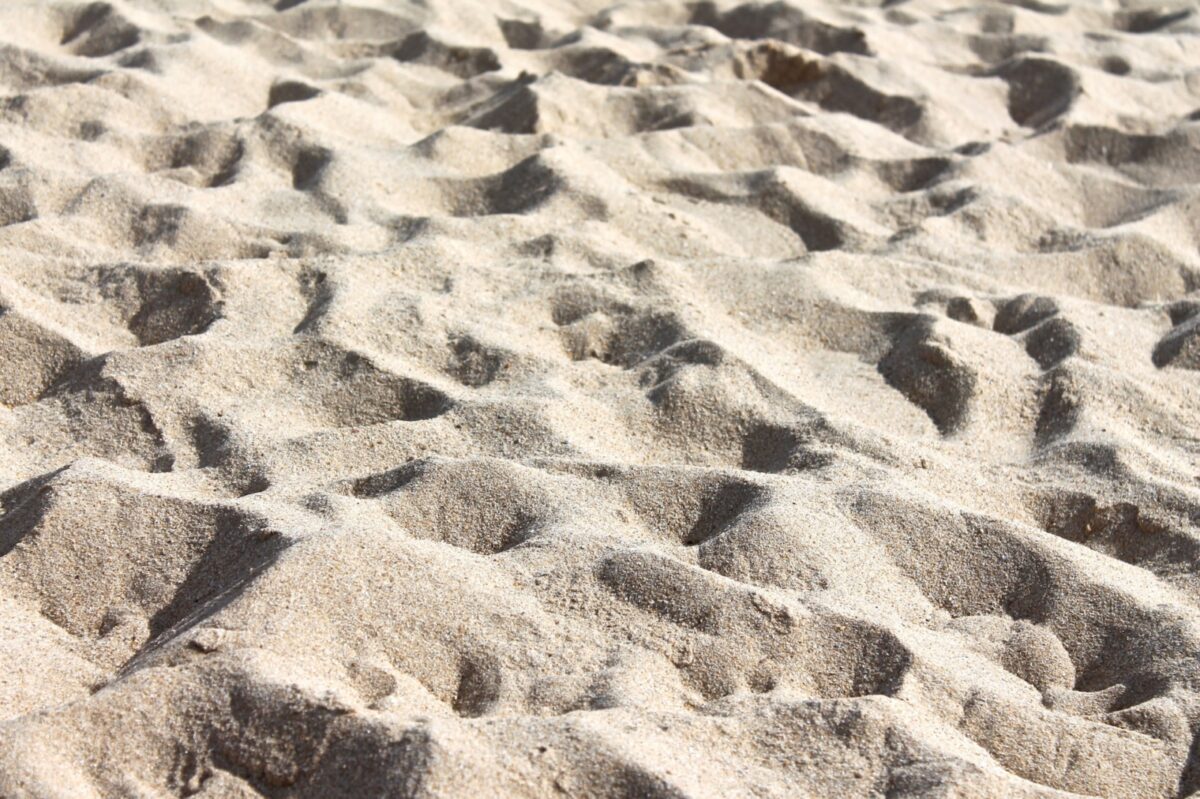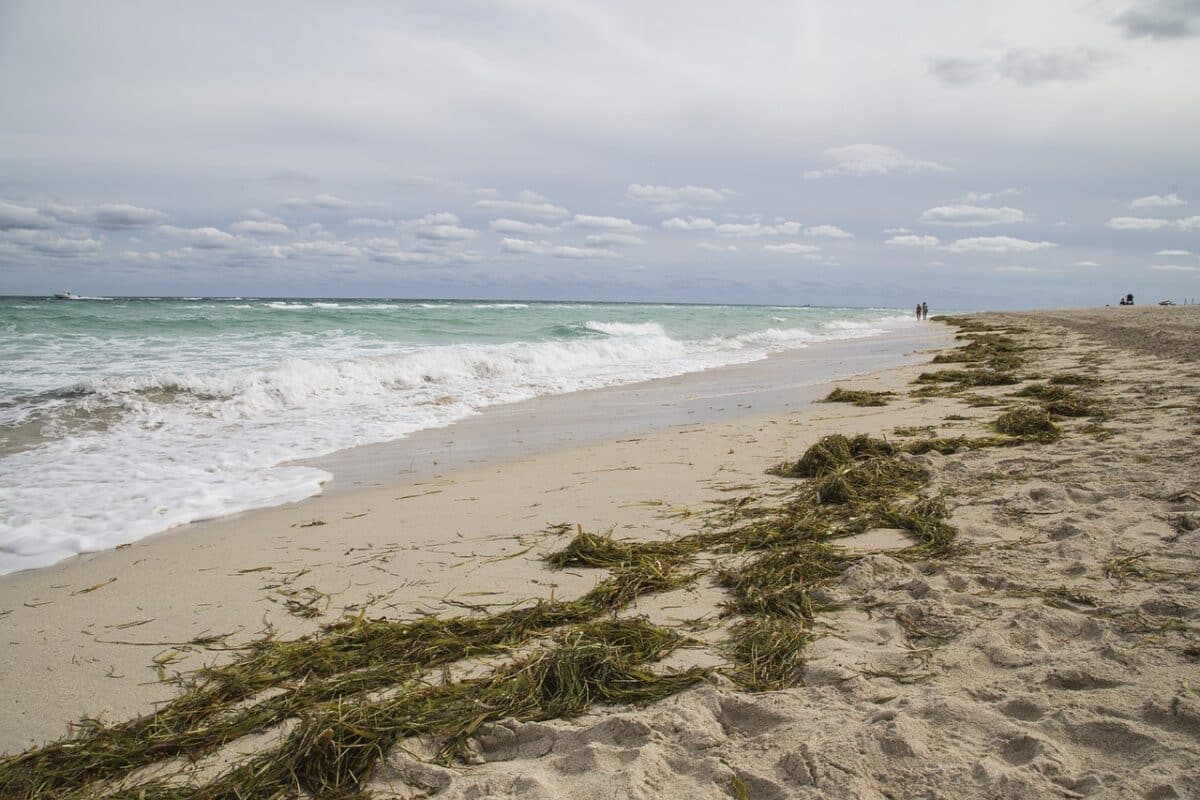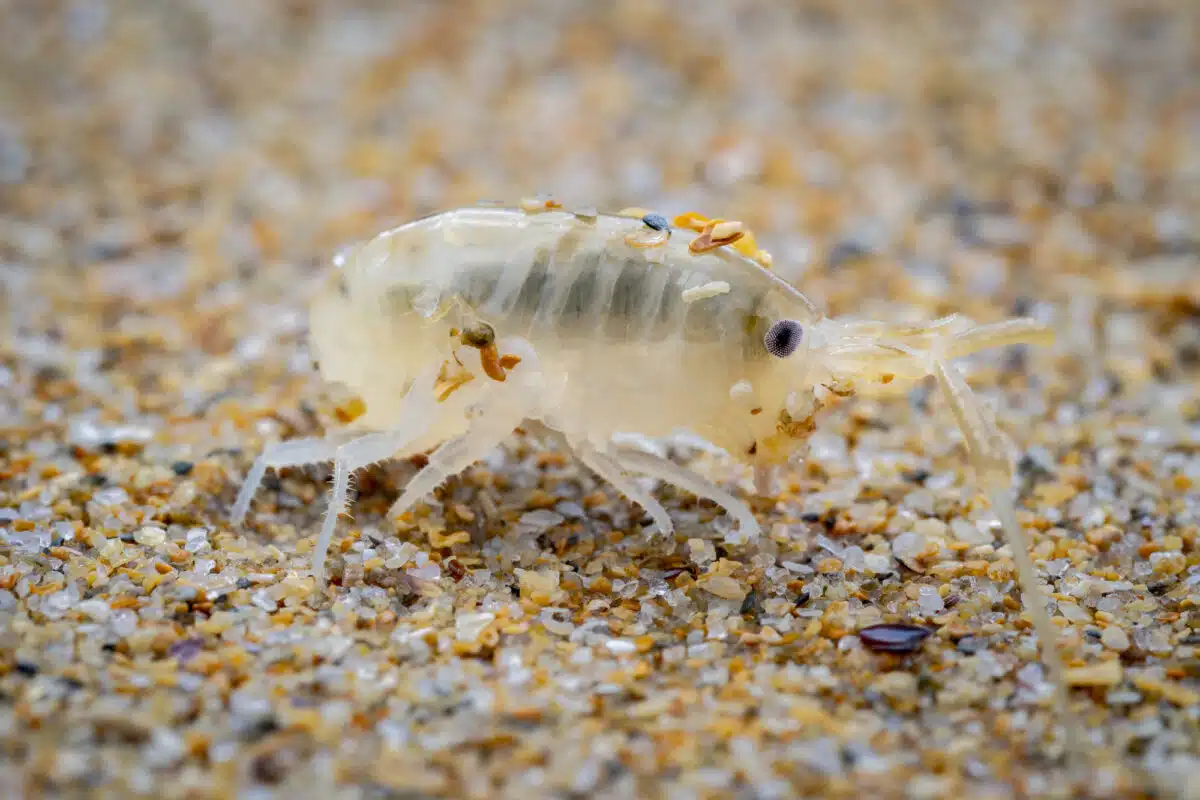In this post we’re going to investigate a pesky yet impressive little creature that can cause havoc during a beach day: the sand flea.

The mention of fleas never with a positive connotation and is more often met with panic and placebo itchiness. This article will discuss this intriguing species, not because they are ectoparasites to other animals, but rather because they have some superb jumping skills.
Now, of course, the common name sand flea can cause some confusion as it might be in reference to three different types of animals. Fleas are insects, but sand fleas on the other hand, are crustaceans. Of course, there are other crustaceans, also known as sand fleas, but they are more commonly known as sand crabs. As you can see, common animal names are often cause of great ambiguity and confusion.
The sand fleas are also known as beach hoppers, sand hoppers, land hoppers, beach fleas, and long shrimp. If you are interested to know about the features and characteristics of these tiny creatures, come along and let’s dive into the discussion.
An Introduction to Sand Fleas
Scientific Name: Family – Tailride
Sand fleas are named so because they have amazing jumping abilities. They are some pretty amazing crustaceans because some of them, most commonly known as lawn shrimp, are wholly terrestrial! They are some of the only crustaceans that have been able to move from water to land (though they do still require moisture to keep from drying out.) In fact, they are one of few species that can be found in marine to freshwater intertidal areas and holy terrestrial environments.
Long shrimp is a pretty apt name because these animals look a lot like shrimp. They have two sets of antennae, with one appearing much larger than the other, and while they may appear white, they are pale shades of brown and green in color when they are still alive. Upon death, they often turn pink or red.
Physical Characteristics
In size, they range from 0,2 to 0,8 inches (5 to 20 millimeters,) but can jump incredible distances. The species found in the United States or the Atlantic, the sandhopper, is about one inch long.
A single sand flea may be able to jump to heights of one foot and a distance of three feet in a single jump. Taking the proportions of their bodies into account, that would be as if a human jumped about 25 feet high and 75 feet far in a single leap. This would be higher than the length of a giraffe, and as far as two buses – it sounds terrifying!
These are found in a variety of colors, like brown, gray, or greenish. These insects have numerous pairs of legs as well as tick-long antennas. Also, they have two forked appendages that come out from the back side of their bodies.
Habitat and Distribution

Range: Nearly worldwide but absent in polar regions.
As the name indicates, sand fleas live in the sand. They live on sandy beaches near the high tide mark. They are active at night and hunt for food, while during the day time, they stay in the sand.
Sand fleas are prevalent in Western Europe and found along the Atlantic coast. Moreover, they are present on the Gulf coast, where they are known as the common Gulf sand hopper or western Gulf sand hopper. They are the insects that are used for kelp removal found on Santa Barbara beaches.
Some are found on icy shores at high latitudes, and these are less abundant in tropical regions. They are mostly found in temperate zones where the temperature is moderate.
These tiny creatures are especially commonly found in the Southern Hemisphere, New Zealand, particularly in Australia, and South Africa. Although these species can live without needing to specifically return to the water, they do still require moisture to survive.
Sand fleas commonly found on beaches and generally come out at night, typically seen hiding under debris or washed-up seaweed bundles. They are often used as an indicator that their habitats are healthy.
Diet
Both male and female sand fleas rely on plant juices, algae, detritus, and sugary secretions. Sand fleas are omnivores that eat anything. They also eat animals and dead plants, small insects, and invertebrates; if there are multiple food sources present, they move towards them.
Also, they need a lot of moisture for their survival. Therefore, they love to live near water bodies to stay hydrated. Moreover, if the sand becomes dry, they quickly relocate to a different habitat.
Life Cycle
The life cycle and development of sand fleas consist of four stages. These include the egg-, pupa-, larva-, and adult stages. Eggs hatch after four to twenty days, depending on weather conditions. The hatching is delayed in the winter, while it takes a shorter time during summer.
Larval stages have four instars and are completed after 20 to 30 days, depending on nutritional availability, temperature, and the species of the sand flea. Extreme weather conditions cause diapause prolonging, and development may be prolonged by several months.
The larvae are scavengers that eat dead matter and fungus. The larvae stage lasts six to thirteen days before they finally transform into adults.
In short: sand fleas lay eggs in the sand, where these eggs hatch. Larvae move deep in the sand to convert into pupae. After a few weeks, they come out as adult fleas. This cycle then begins again (and again and again and again.)
Don’t Confuse Sand Fleas With Sand Flies
If you think sand fleas are the same as sand flies, then you are wrong – but definitely not the first one to make this mistake. They are two very distinct creatures. Sand flies cause mosquito-like bites. Sometimes they carry parasites, which they pass onto people through their bites. One of these includes Leishmania parasites, causing leishmaniasis disease. This disease results in skin wounds, organ damage and infections. In extreme cases, without treatment, it may result in the death of a person.
Misconceptions About Sand Fleas
Sometimes itchy red skin may occur because of sand flies, not sand fleas. Sand flies are blood feeders and belong to the group of insects called sandflies. Moreover, sand fleas are confused with jigger fleas that burrow in human skin and cause severe infections. Crustaceans bite but are not as deep as compared to these jigger fleas.
How Sand Fleas Enter Your Home
These amphipods are a nuisance as they can stick onto your clothing and then come home with you. The terrestrial amphipods, also known as land shrimp, typically do not cause any problems and prefer staying in sandy beach environments.
However, when you visit the beach, they may stick to your clothing, and then you bring them home with you, and they become your guests. They jump here and there, so they can spread fairly quickly.
Are Sand Fleas Harmful To Humans?
Sand fleas are somewhat harmful to people, and if they bite, they cause red itchy bumps on the skin. Some are harmless, while others cause serious skin problems, diseases, or infections.
Certain species are very dangerous. Usually, the itchy skin goes away after a few days, but in some more severe cases, doctors recommend some anti-infectives for a quicker recovery.
The true sand fleas are also known as Tonga Penetrans or chigoe fleas. These fleas bore holes in your skin. They may also cause tungiasis, known as the sand flea’s disease. This disease causes skin lesions and severe inflammation.
Why Are These Crustaceans Called Fleas?
The harmless sand fleas are not fleas nor insects. They belong to the same family as lobsters and crabs. But, because of their jumping and hopping abilities, they are known as fleas. They are known by many different names – they are also known as beachy, fleas or hoppers, and sand hoppers.
How Do Sand Fleas Differ From Regular Fleas?
Regular fleas are very different from sand fleas. But some similarities do exist. Both live on wild or domestic animals. Also, they have the ability to transmit disease.
“Normal fleas” live on humans, while sand fleas don’t live on the skin of people. Moreover, regular fleas do not cause serious skin wounds as sand fleas can.
Who Can Get Sand Flea Bites?
Anyone in the vicinity of sand fleas are at risk of being bitten. They may cause mild bites as well as dangerous bites, depending on the biting intensity. They live in humid conditions. So, if someone walks barefoot on the beach with moist feet, sand fleas are quite prone to take a nibble.
People who play in the sand or shallow water oftentimes get bites. Also, in underdeveloped or poor rural regions, where there is sand all around, people who spend time barefooted are especially prone to getting bites from sand fleas. Farmers, people who stand on dirt floors and walk barefoot on streets, are at the highest risk.
Also, young children with low immunity, aged people, and those who are disabled are particularly susceptible to the diseases that these creatures may pass on. Moreover, these diseases are usually more common in dry seasons like September and August.
As previously mentioned, the sand flea is a common cause for parasitic infections in rural communities. In Atlantic areas and Asian territories where sand fleas are common, such diseases are much more common. About 60% of adults and 80% of children have suffered from disease due to sand fleas.
Why Do Sand Fleas Bite?
The Sand flea bites on ankles and feet. Also, they look for soft fleshy areas to bite. They do skin burrowing at heels, toes, or under the toenails. Also, if you lie in the sand, then these fleas may bite you on your hands, thighs, genitals, or groin.
Usually, female sand fleas bite to suck blood by burrowing it into flesh. In this way, it develops and grows. They can swell up many times their original size by sucking blood.
Ways To Prevent Sand Flea Bites
Sand fleas bite when people walk barefoot in the area where their colonies are present. One way to prevent the bite of the flea is to wear socks or stockings. Also, by avoiding the shoreline at night, you prevent attacks from these pesky hoppers.
Moreover, one can use topical bug sprays to help keep the crustaceans away from your skin. Also, crustaceans come out when it’s raining, so one should be extra mindful during bad weather.
Because of the itchy bites they generate, they are a nuisance that also cause secondary infections. These also live in the hair, so it is important to prevent infestation and treat your hair with particular flea shampoo or the use of topical cream if you know that you’ve been exposed.
One can use a flea bomb or fogger to kill insects of this kind, although this should be a last resort due to its negative impact on the environment.
To get rid of sand fleas, it is also important to keep your place clean and eliminate any food they like. Thus, keeping the yard free of debris can likewise help prevent sand flea infection. The removal of stagnant water from the place will prevent them from laying eggs on these surfaces.
Moreover, regular vacuums on the property and sealing services or cracks can also prevent any sorts of insects from making colonies. In this way, there are fewer chances that fleas can nest in these holes.
Treatment For Sand Flea Bites
Beach days are a lot of fun, but when you come home with itchy, red ankles and legs, your fun day can turn into an uncomfortable experience. These pesky insects that produce these mouthfuls are called sand fleas, and when they suck, they leave behind saliva that causes itchiness. Fortunately, by using home remedies, you can relieve your itchiness very efficiently and quickly.
Bottom Line
| Key Points |
| Sand fleas are not insects. Rather they are crustaceans |
| Sand fleas live in habitats with lots of moisture, preferably beaches. |
| Their bites cause red itchy skin when they bite, and may sometimes pass on various viruses and diseases. |
| They are a distinctly different species from sand flies |
| Female sand fleas sometimes suck blood from humans and other animals. |
Sand fleas are crustaceans that look and behave like fleas. Rather they have shells and look like crabs or lobsters. They frequently bite humans, especially on our feet, toes, and the skin between our toes. They live in habitats with lots of moisture. Therefore, they bite immediately when they come across some moistened skin.
Sand fleas lay eggs on the sand. When these egg hatch, the resulting larvae burrow in the sand, pupate, and then become adult fleas that crawl out of the sand. Flea bites cause redness as well as itchiness. Sometimes they pose a much greater danger by passing on various diseases to humans, which sometimes may be life-threatening if not tended to. So one should always be mindful of using flea spray or wearing socks when resting on the sand to prevent the biting of these tiny creatures if you’re in an area where sand fleas are abundant.
Thank you for reading this article! There are various insects out there that are often overlooked due to their tiny size although they are cause for awe, keep reading about insects and take a look at our post on the Black Wasp.
Join our Forum for free today!





